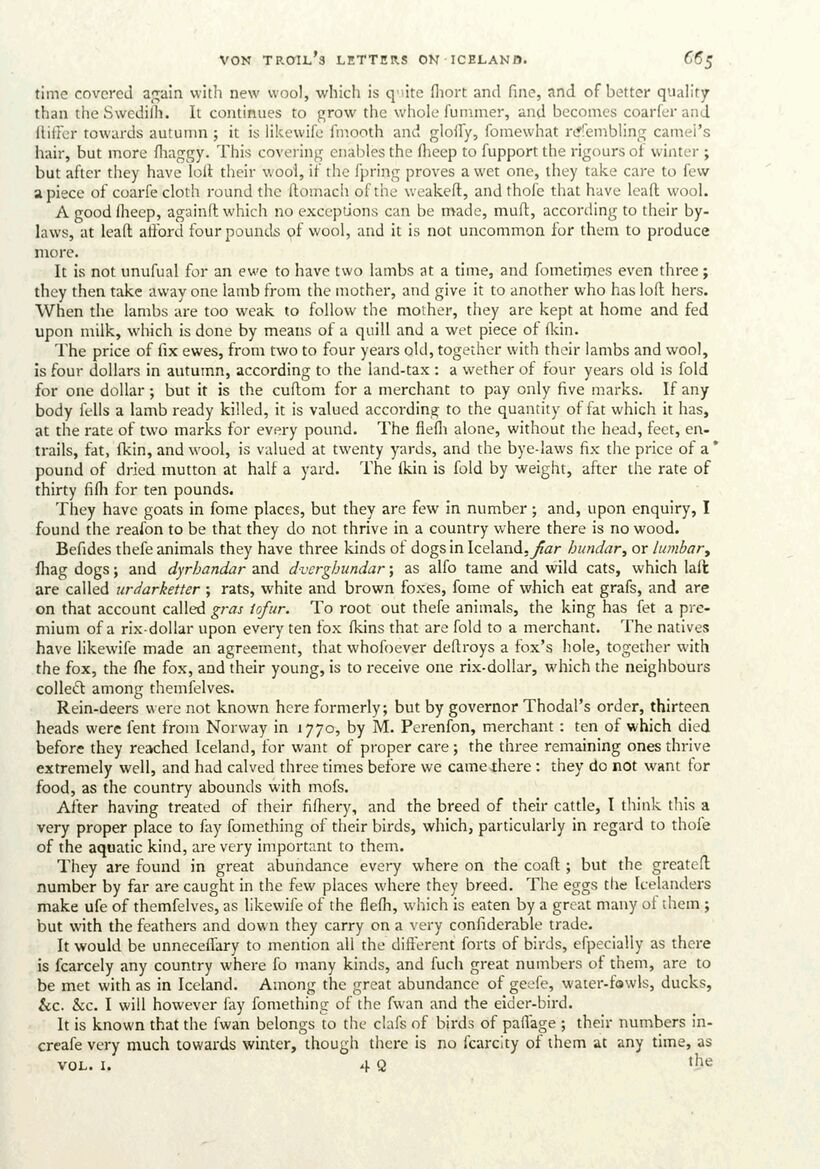
Full resolution (JPEG) - On this page / på denna sida - Pages ...

<< prev. page << föreg. sida << >> nästa sida >> next page >>
Below is the raw OCR text
from the above scanned image.
Do you see an error? Proofread the page now!
Här nedan syns maskintolkade texten från faksimilbilden ovan.
Ser du något fel? Korrekturläs sidan nu!
This page has never been proofread. / Denna sida har aldrig korrekturlästs.
VON TROIL’3 LETTERS ON ICELAND. 665
time covered again with new wool, which is quite fhort and fine, and of better quality
than the Swedifh. It continues to grow the whole fummer, and becomes coarfer and
{tiffer towards autumn ; it is likewife fmooth and glofly, fomewhat refembling camel’s
hair, but more fhaggy. This covering enables the fheep to fupport the rigours of winter ;
but after they have loit their wool, if the fpring proves a wet one, they take care to few
apiece of coarfe cloth round the ftomach of the weakeft, and thofe that have leaft wool.
A good theep, again{t which no exceptions can be made, mutt, according to their by-
laws, at leaft afford four pounds of wool, and it is not uncommon for them to produce
more.
It is not unufual for an ewe to have two lambs at a time, and fometimes even three ;
they then take away one lamb from the mother, and give it to another who has loft hers.
When the lambs are too weak to follow the mother, they are kept at home and fed
upon milk, which is done by means of a quill and a wet piece of {kin.
The price of fix ewes, from two to four years old, together with their lambs and wool,
is four dollars in autumn, according to the land-tax: a wether of four years old is fold
for one dollar; but it is the cuftom for a merchant to pay only five marks. If any
body fells a lamb ready killed, it is valued according to the quantity of fat which it has,
at the rate of two marks for every pound. The flefh alone, without the head, feet, en-
trails, fat, fkin, and wool, is valued at twenty yards, and the bye-laws fix the price of a”
pound of dried mutton at half a yard. ‘The fkin is fold by weight, after the rate of
thirty fifh for ten pounds.
They have goats in fome places, but they are few in number ; and, upon enquiry, I
found the reafon to be that they do not thrive in a country where there is no wood.
Befides thefe animals they have three kinds of dogsin Iceland, far hundar, or lumbar,
fhag dogs; and dyrhandar and dverghundar; as alfo tame and wild cats, which lat
are called urdarketter ; rats, white and brown foxes, fome of which eat grafs, and are
on that account called gras tofur. To root out thefe animals, the king has fet a pre-
mium of a rix-dollar upon every ten fox fkins that are fold to a merchant. ‘The natives
have likewife made an agreement, that whofoever deftroys a fox’s hole, together with
the fox, the fhe fox, and their young, is to receive one rix-dollar, which the neighbours
collect among themfelves.
Rein-deers were not known here formerly; but by governor Thodal’s order, thirteen
heads were fent from Norway in 1770, by M. Perenfon, merchant : ten of which died
before they reached Iceland, for want of proper care; the three remaining ones thrive
extremely well, and had calved three times before we camethere: they do not want for
food, as the country abounds with mofs.
After having treated of their fifhery, and the breed of their cattle, I think this a
very proper place to fay fomething of their birds, which, particularly in regard to thofe
of the aquatic kind, are very important to them.
They are found in great abundance every where on the coaft; but the greateft
number by far are caught in the few places where they breed. The eggs the Icelanders
make ufe of themfelves, as likewife of the flefh, which is eaten by a great many of them ;
but with the feathers and down they carry ona very confiderable trade.
It would be unneceflary to mention all the different forts of birds, efpecially as there
is fcarcely any country where fo many kinds, and fuch great numbers of them, are to
be met with as in Iceland. Among the great abundance of geefe, water-fewls, ducks,
&c. &c. I will however fay fomething of the fwan and the eider-bird.
It is known that the fwan belongs to the clafs of birds of paflage ; their numbers in-
creafe very much towards winter, though there is no fearcity of them at any time, as
VOL. I. 44 Q the
<< prev. page << föreg. sida << >> nästa sida >> next page >>